Bind data from SQL server to ASP.NET Core controls
4 Dec 202420 minutes to read
In this topic, we are going to learn how to retrieve data from SQL database using Entity Framework to bind it to the Grid control and perform CRUD operations.
Entity Framework is an open-source object-relational mapper (O/RM) from Microsoft. Entity Framework works with many databases. But here, we are going to discuss the step-by-step procedure to create an Entity Framework using the MS SQL Server database and connect it to the Syncfusion® control to perform CRUD operations in a ASP.NET Core Application.
Prerequisite software
The following software are needed
- Visual Studio 2022 v17.0 or later.
- .NET SDK 6.0 or later.
Create the database
The first step is to create a Library database and a table named Book to hold a list of books.
- Open SQL Server Object Explorer.
- Now, create a new database named Library.
- Right-click on the created database and select New Query.
- Use the following SQL query to create a table named Book.
Create Table Book(
Id BigInt Identity(1,1) Primary Key Not Null,
Name Varchar(200) Not Null,
Author Varchar(100) Not Null,
Quantity int,
Price int Not Null,
Available bit
)Now, the Book table design will look like below.
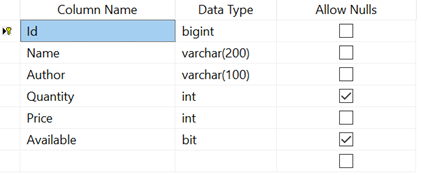
Create ASP.NET Core MVC Application
Open Visual Studio and follow the steps in the below documentation to create the Application.
Creating DbContext and model class
Now, we are going to scaffold DbContext and model classes from the existing Library database. To perform scaffolding and work with the SQL Server database in our application, we need to install the following NuGet packages.
Run the following commands in the Package Manager Console.
- Install-Package Microsoft.EntityFrameworkCore.Tools -Version 6.0.2: This package creates database context and model classes from the database.
- Install-Package Microsoft.EntityFrameworkCore.SqlServer -Version 6.0.2: The database provider allows Entity Framework Core to work with SQL Server.
Once the above packages are installed, we can scaffold DbContext and Model classes. Run the following command in the Package Manager Console under the LibraryManagement project.
Scaffold-DbContext “Data Source=(localdb)\MSSQLLocalDB;Initial Catalog=Library;Integrated Security=True;Connect Timeout=30;Encrypt=False;TrustServerCertificate=False;ApplicationIntent=ReadWrite;MultiSubnetFailover=False” Microsoft.EntityFrameworkCore.SqlServer -OutputDir ModelsThe above scaffolding command contains the following details for creating DbContext and model classes for the existing database and its tables.
- Connection string: Data Source=(localdb)\MSSQLLocalDB;Initial Catalog=Library;Integrated Security=True;Connect Timeout=30;Encrypt=False;TrustServerCertificate=False;ApplicationIntent=ReadWrite;MultiSubnetFailover=False
- Data provider: Microsoft.EntityFrameworkCore.SqlServer
- Output directory: -OutputDir Models
After running the above command, LibraryContext.cs and Book.cs files will be created under the LibraryManagement.Models folder as follows.
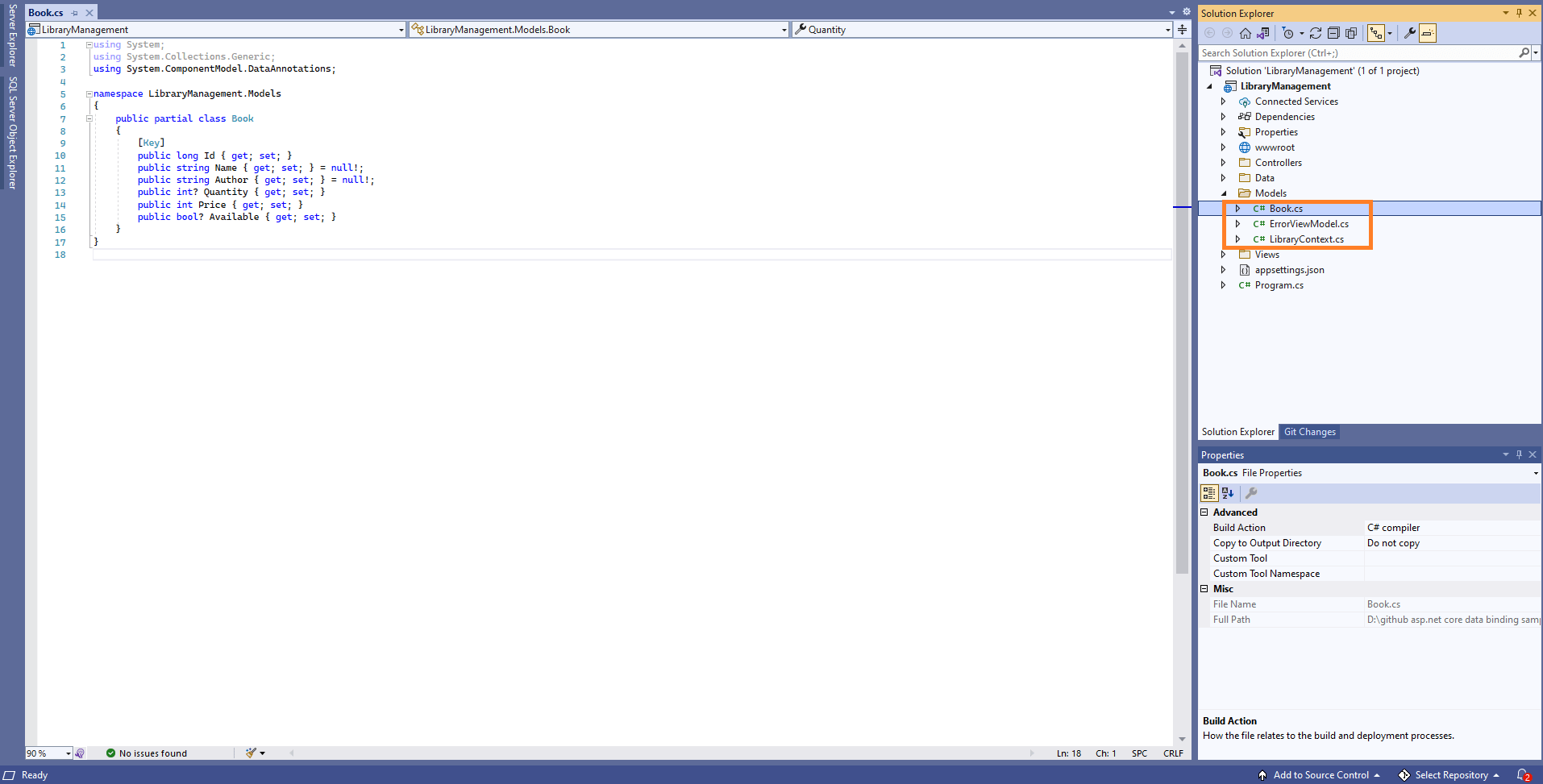
The LibraryContext.cs file contains the connection string details in the OnConfiguring method.
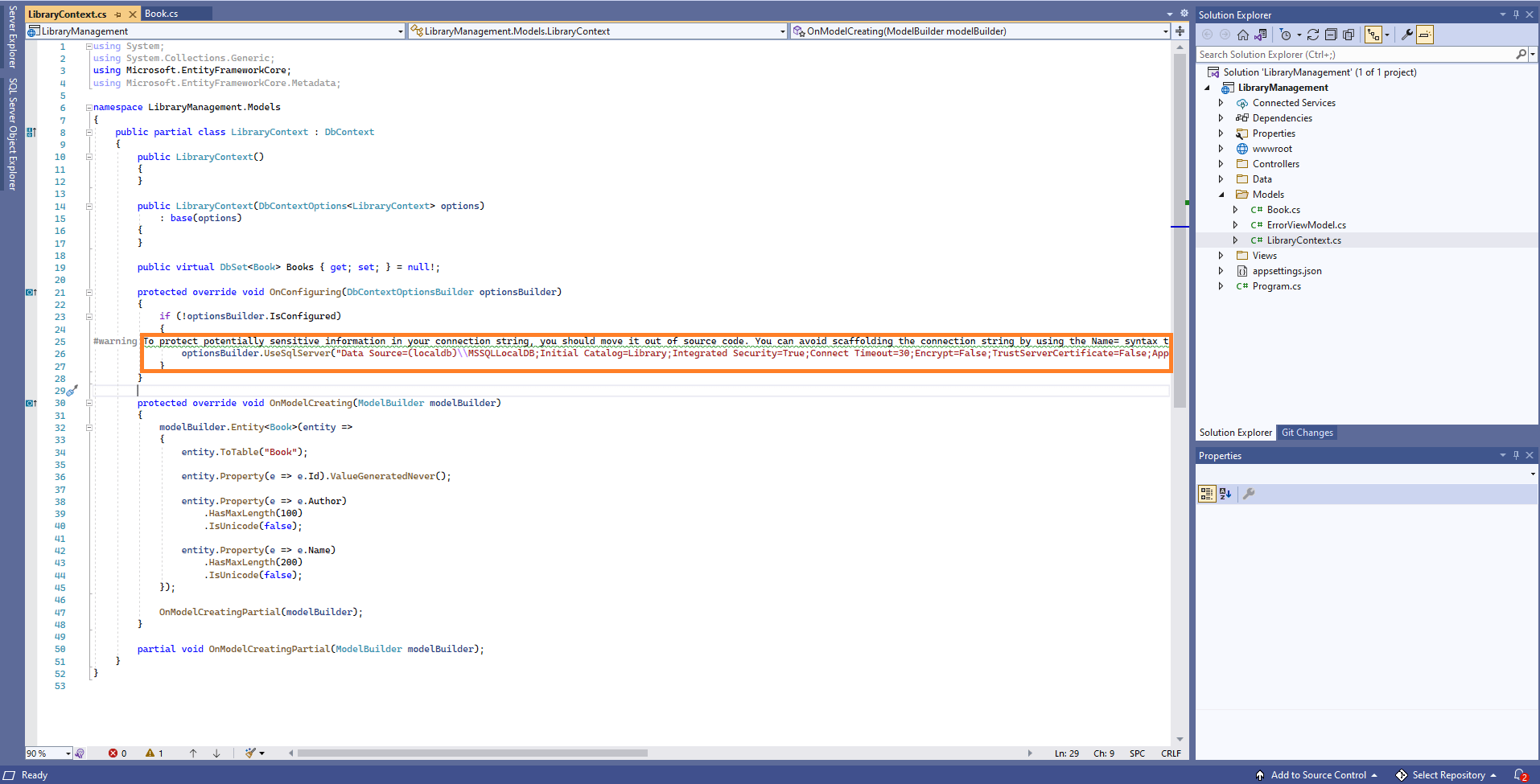
It is not recommended to have a connection string with sensitive information in the LibraryContext.cs file, so the connection string is moved to the app settings.json file.
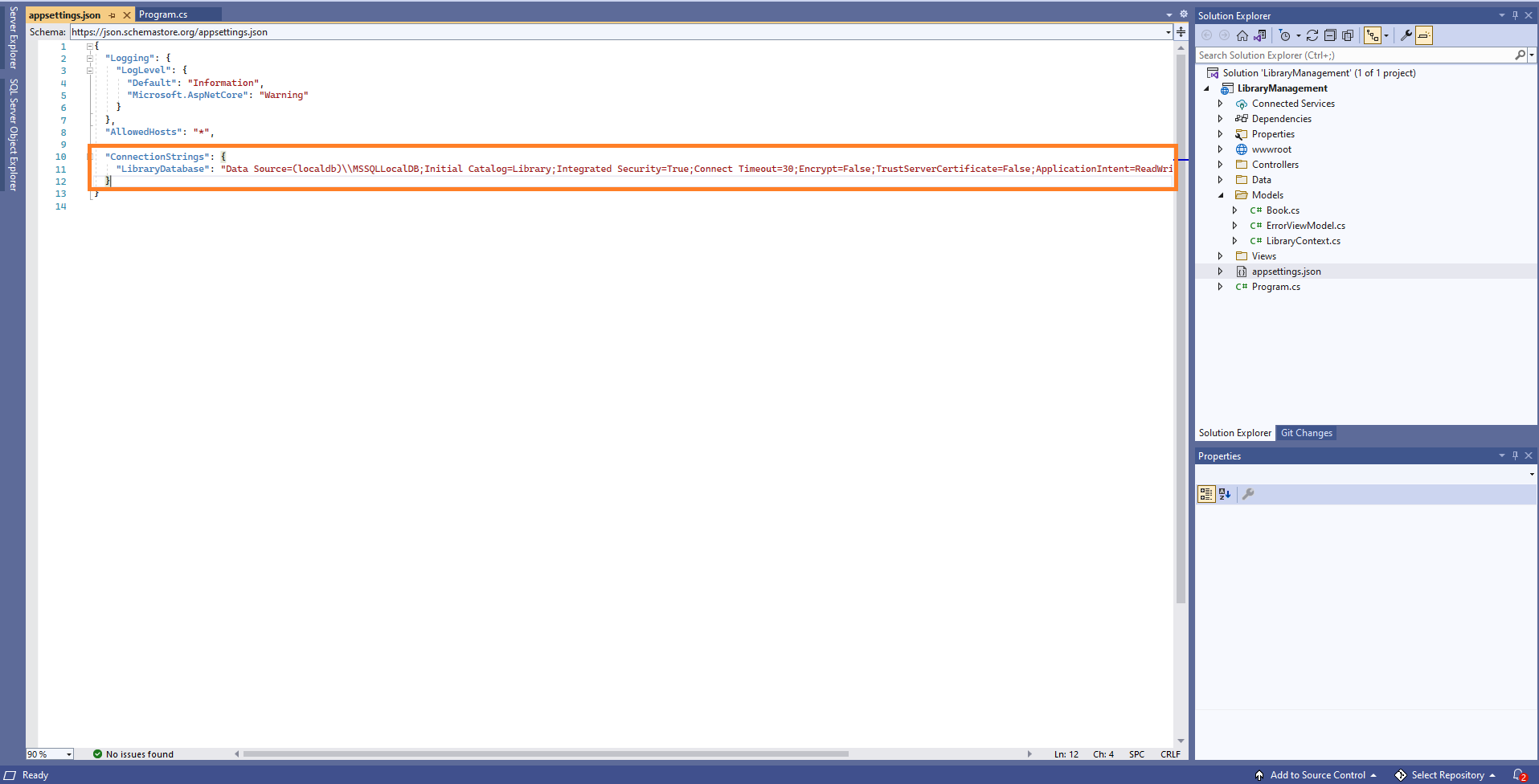
Now, the DbContext must be configured using connection string and registered as scoped service using the AddDbContext method in Program.cs.
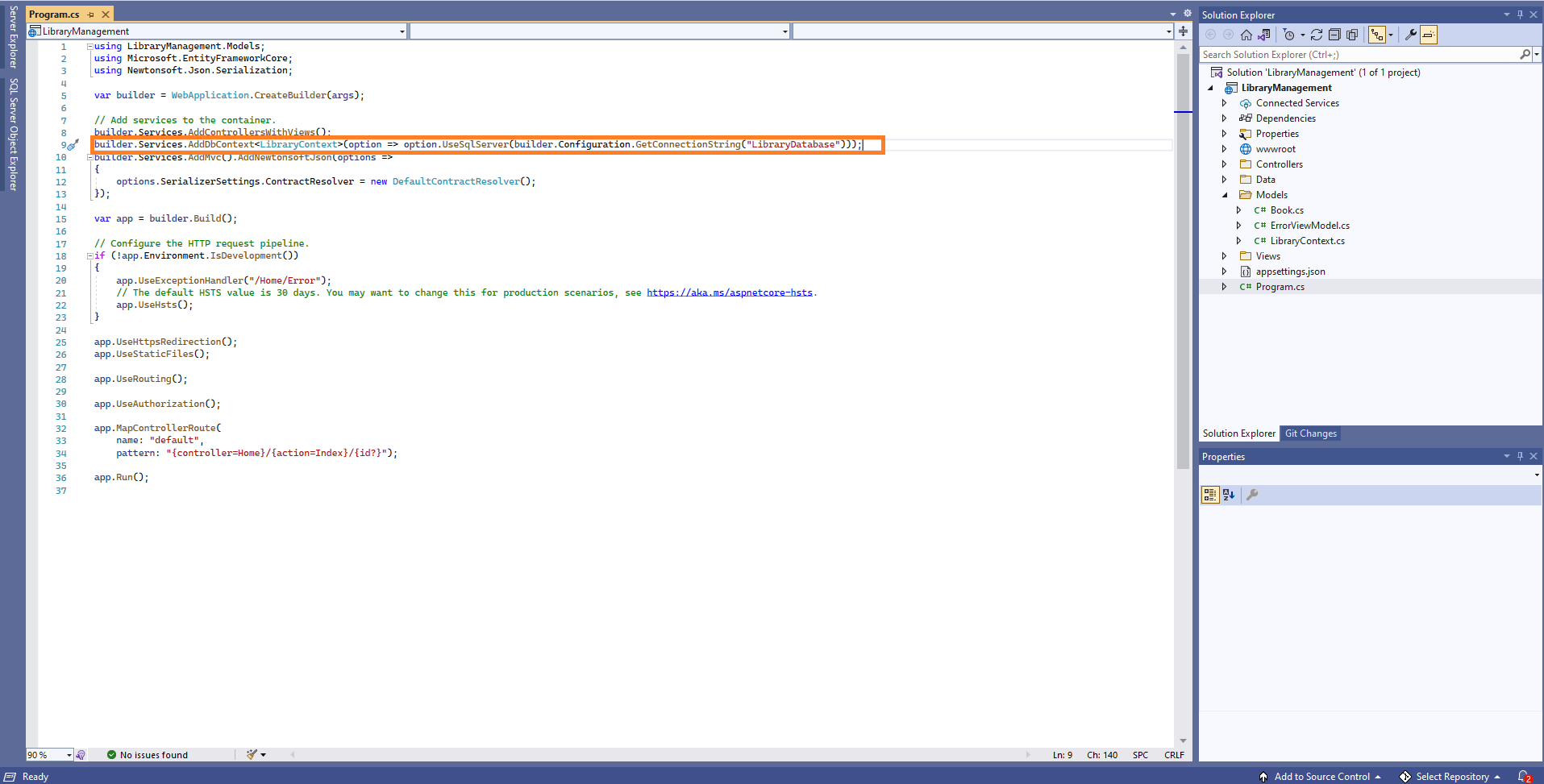
Creating a Data Access Layer in controller
The application is now configured to connect with the Library database using Entity Framework. Now, it’s time to consume data from the Library database. To do so, modify the Home controller to serve data from the DbContext to the ASP.NET Core application.
Now, replace the Home controller with the following code which contains code to handle CRUD operations in the Book table.
using LibraryManagement.Models;
using Microsoft.AspNetCore.Mvc;
using System.Diagnostics;
using Syncfusion.EJ2.Base;
namespace LibraryManagement.Controllers
{
public class HomeController : Controller
{
private readonly LibraryContext _context;
public HomeController(LibraryContext context)
{
_context = context;
}
public IActionResult Index()
{
return View();
}
public IActionResult Privacy()
{
return View();
}
[ResponseCache(Duration = 0, Location = ResponseCacheLocation.None, NoStore = true)]
public IActionResult Error()
{
return View(new ErrorViewModel { RequestId = Activity.Current?.Id ?? HttpContext.TraceIdentifier });
}
public IActionResult UrlDatasource([FromBody] DataManagerRequest dm)
{
IEnumerable<Book> DataSource = _context.Books.ToList();
int count = DataSource.Cast<Book>().Count();
return Json(new { result = DataSource, count = count });
}
public ActionResult Insert([FromBody] ICRUDModel<Book> value)
{
_context.Books.Add(value.Value);
_context.SaveChanges();
return Json(value);
}
public IActionResult Update([FromBody] ICRUDModel<Book> value)
{
var ord = value;
Book val = _context.Books.Where(or => or.Id == ord.Value.Id).FirstOrDefault();
val.Id = ord.Value.Id;
val.Name = ord.Value.Name;
val.Author = ord.Value.Author;
val.Quantity = ord.Value.Quantity;
val.Price = ord.Value.Price;
val.Available = ord.Value.Available;
_context.SaveChanges();
return Json(value);
}
public IActionResult Delete([FromBody] ICRUDModel<Book> value)
{
Book order = _context.Books.Where(c => c.Id == (int)value.key).FirstOrDefault();
_context.Books.Remove(order);
_context.SaveChanges();
return Json(order);
}
public class ICRUDModel<T> where T : class
{
public int? key { get; set; }
public T Value { get; set; }
}
}
}Install ASP.NET Core package in the application
Syncfusion® ASP.NET Core controls are available in nuget.org.. Refer to NuGet packages topic to learn more about installing NuGet packages in various OS environments. To add ASP.NET Core controls in the application, open the NuGet package manager in Visual Studio (Tools → NuGet Package Manager → Manage NuGet Packages for Solution), search for Syncfusion.EJ2.AspNet.Core and then install it.
NOTE
The Syncfusion.EJ2.AspNet.Core NuGet package has dependencies, Newtonsoft.Json for JSON serialization and Syncfusion.Licensing for validating Syncfusion® license key.
Add Syncfusion® ASP.NET Core Tag Helper
Open ~/Views/_ViewImports.cshtml file and import the Syncfusion.EJ2 TagHelper.
@addTagHelper *, Syncfusion.EJ2Add Style Sheet
Checkout the Themes topic to learn different ways (CDN, NPM package, and CRG) to refer styles in ASP.NET Core application, and to have the expected appearance for Syncfusion® ASP.NET Core controls. Here, the theme is referred using CDN inside the <head> of ~/Views/Shared/_Layout.cshtml file as follows,
<head>
...
<!-- Syncfusion ASP.NET Core controls styles -->
<link rel="stylesheet" href="https://cdn.syncfusion.com/ej2/32.1.19/material.css" />
</head>Add Script Reference
In this getting started walk-through, the required scripts are referred using CDN inside the <head> of ~/Views/Shared/_Layout.cshtml file as follows,
<head>
...
<!-- Syncfusion ASP.NET Core controls scripts -->
<script src="https://cdn.syncfusion.com/ej2/32.1.19/dist/ej2.min.js"></script>
</head>Register Syncfusion® Script Manager
Open ~/Views/Shared/_Layout.cshtml page and register the script manager
<body>
...
<!-- Syncfusion Script Manager -->
<ejs-scripts></ejs-scripts>
</body>Add Syncfusion® DataGrid control to an application
In previous steps, the Syncfusion® ASP.NET Core package is successfully configured in the application. Now, add the grid control to your Index.cshtml view page which is present under Views/Home folder.
<ejs-grid id="Grid"></ejs-grid>Binding data to Grid control using Entity Framework
To consume data from the Home Controller, add the DataManager with UrlAdaptor.
<ejs-grid id="Grid">
<e-data-manager url="/Home/UrlDataSource" adaptor="UrlAdaptor" insertUrl="/Home/Insert" removeUrl="/Home/Delete" updateUrl="/Home/Update" crossDomain="true"></e-data-manager>
</ejs-grid>Grid columns can be defined by using the GridColumn component.
<ejs-grid id="Grid" toolbar="@(new List<string>() { "Add", "Edit", "Delete", "Cancel", "Update" })">
<e-data-manager url="/Home/UrlDataSource" adaptor="UrlAdaptor" insertUrl="/Home/Insert" removeUrl="/Home/Delete" updateUrl="/Home/Update" crossDomain="true"></e-data-manager>
<e-grid-editSettings allowDeleting="true" allowEditing="true" allowAdding="true"></e-grid-editSettings>
<e-grid-columns>
<e-grid-column field="Id" headerText="Order ID" type="number" visible="false" textAlign="Right" width="120" isPrimaryKey="true"></e-grid-column>
<e-grid-column field="Name" headerText="Name" type="string" width="140"></e-grid-column>
<e-grid-column field="Author" headerText="Author" type="string" textAlign="Right" width="120"></e-grid-column>
<e-grid-column field="Quantity" headerText="Quantity" type="number" textAlign="Right" width="140"></e-grid-column>
<e-grid-column field="Price" headerText="Price" type="number" textAlign="Right" format="C2" width="120"></e-grid-column>
<e-grid-column field="Available" headerText="Available" editType="booleanedit" displayAsCheckBox="true" type="boolean" textAlign="Right" width="140"></e-grid-column>
</e-grid-columns>
</ejs-grid>When you run the application, the UrlDatasource method will be called in your controller to load the datasource.
using LibraryManagement.Models;
using Microsoft.AspNetCore.Mvc;
using System.Diagnostics;
using Syncfusion.EJ2.Base;
namespace LibraryManagement.Controllers
{
public class HomeController : Controller
{
private readonly LibraryContext _context;
public HomeController(LibraryContext context)
{
_context = context;
}
public IActionResult UrlDatasource([FromBody] DataManagerRequest dm)
{
IEnumerable<Book> DataSource = _context.Books.ToList();
int count = DataSource.Cast<Book>().Count();
return Json(new { result = DataSource, count = count });
}
...
}
}The response object from the Web API should contain the properties Items and Count, whose values are a collection of entities and the total count of the entities respectively.
{
"Items": [{..}, {..}, {..}, ...],
"Count": 830
}Handling CRUD operations with ASP.NET Core Grid control
The editing can be enabled in the grid control using the GridEditSettings component. Grid provides various modes of editing options such as Inline/Normal, Dialog, and Batch editing.
Here, Inline edit mode and Toolbar property are used to show toolbar items for editing.
The Grid Editing and Toolbar code are added with previous Grid model.
<ejs-grid id="Grid" actionBegin="actionBegin" actionComplete="actionComplete" toolbar="@(new List<string>() { "Add", "Edit", "Delete", "Cancel", "Update" })">
<e-data-manager url="/Home/UrlDataSource" adaptor="UrlAdaptor" insertUrl="/Home/Insert" removeUrl="/Home/Delete" updateUrl="/Home/Update" crossDomain="true"></e-data-manager>
<e-grid-editSettings allowDeleting="true" allowEditing="true" allowAdding="true"></e-grid-editSettings>
<e-grid-columns>
<e-grid-column field="Id" headerText="Order ID" type="number" visible="false" textAlign="Right" width="120" isPrimaryKey="true"></e-grid-column>
<e-grid-column field="Name" headerText="Name" type="string" width="140"></e-grid-column>
<e-grid-column field="Author" headerText="Author" type="string" textAlign="Right" width="120"></e-grid-column>
<e-grid-column field="Quantity" headerText="Quantity" type="number" textAlign="Right" width="140"></e-grid-column>
<e-grid-column field="Price" headerText="Price" type="number" textAlign="Right" format="C2" width="120"></e-grid-column>
<e-grid-column field="Available" headerText="Available" editType="booleanedit" displayAsCheckBox="true" type="boolean" textAlign="Right" width="140"></e-grid-column>
</e-grid-columns>
</ejs-grid>NOTE
Normal editing is the default edit mode for the Grid control. Set the IsPrimaryKey property of Column as true for a particular column, whose value is a unique value for editing purposes.
Insert a row
To insert a new row, click the Add toolbar button. The new record edit form will look like below.

Clicking the Update toolbar button will insert the record in the Book table by calling the following Insert method of the insertUrl.
public ActionResult Insert([FromBody] ICRUDModel<Book> value)
{
_context.Books.Add(value.Value);
_context.SaveChanges();
return Json(value);
}
Update a row
To edit a row, select any row and click the Edit toolbar button. The edit form will look like below. Edit the Customer Name column.

Clicking the Update toolbar button will update the record in the Orders table by calling the following Update method of the updateUrl.
public IActionResult Update([FromBody] ICRUDModel<Book> value)
{
var ord = value;
Book val = _context.Books.Where(or => or.Id == ord.Value.Id).FirstOrDefault();
val.Id = ord.Value.Id;
val.Name = ord.Value.Name;
val.Author = ord.Value.Author;
val.Quantity = ord.Value.Quantity;
val.Price = ord.Value.Price;
val.Available = ord.Value.Available;
_context.SaveChanges();
return Json(value);
}
Delete a row
To delete a row, select any row and click the Delete toolbar button. Deleting operation will send a DELETE request to the removeUrl with the selected record`s primary key value to remove the corresponding record from the Book table.
public IActionResult Delete([FromBody] ICRUDModel<Book> value)
{
Book order = _context.Books.Where(c => c.Id == (int)value.key).FirstOrDefault();
_context.Books.Remove(order);
_context.SaveChanges();
return Json(order);
}NOTE